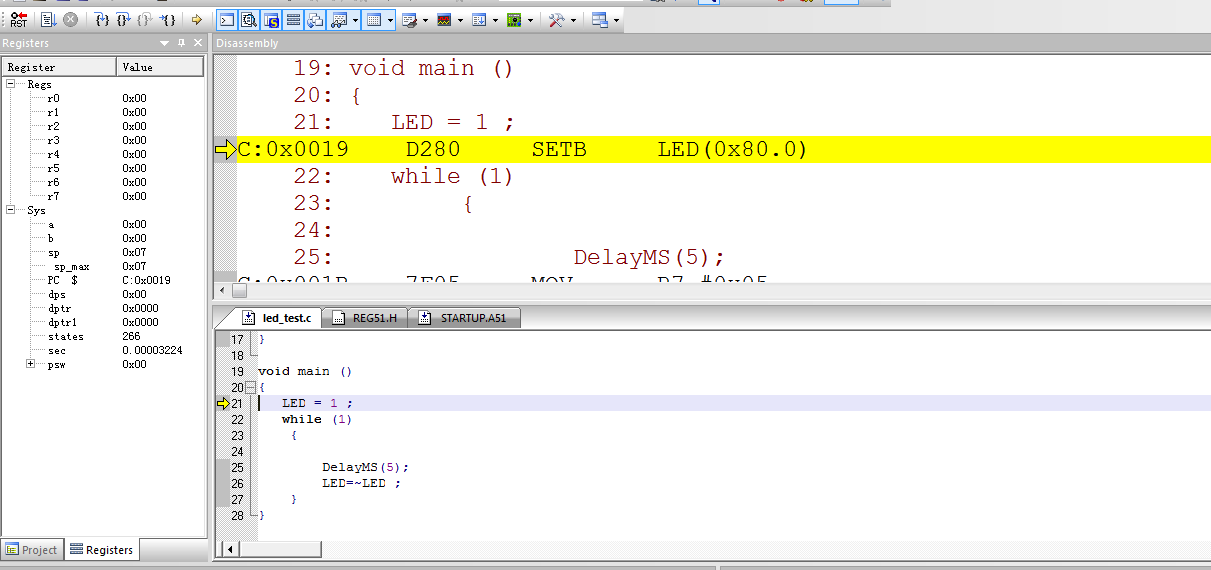基于FPGA的DW8051移植(一)
最近 半个月都在移植8051,看到DW8051内核资料比较齐全又是新思发布的,所以就开始玩弄
可是这半个月的努力几近白费 —— 移植失败了,不知道从何着手这个内核。可能大家能找到不同的版本,我的是最初的版本,里面包含了datasheet 以及一些说明文档,看上去貌似是最原始的(可能已经修改过了),本想传上来,但是我一直到偶没有找到哪里可以上传文件。
我没有添加片外memory,只有片内64k的rom 和256k的ram
首先来看看我的tb
1 `timescale 1us/100ns 2 3 module dw8051_tb ; 4 5 reg clk , reset ; 6 reg int0_n, int1_n ; 7 reg rxd0_in , rxd1_in ; 8 reg t0 , t1 ; 9 10 wire rst_out_n ; 11 wire stop_mode_n, idle_mode_n ; 12 wire rxd0_out , txd0 ; 13 wire rxd1_out , txd1 ; 14 wire t0_out , t1_out ; 15 16 integer i ; 17 18 DW8051_top cpu_core( 19 20 .clk (clk) , 21 .reset (reset) , 22 .rst_out_n (rst_out_n) , 23 .stop_mode_n (stop_mode_n) , 24 .idle_mode_n (idle_mode_n) , 25 26 //int 27 .int0_n (int0_n) , 28 .int1_n (int1_n) , 29 30 //serial port 31 .rxd0_in (rxd0_in) , 32 .rxd0_out (rxd0_out) , 33 .txd0 (txd0) , 34 35 .rxd1_in (rxd1_in) , 36 .rxd1_out (rxd1_out) , 37 .txd1 (txd1) , 38 39 //timer/counter input/output 40 .t0 (t0) , 41 .t1 (t1) , 42 .t0_out (t0_out) , 43 .t1_out (t1_out) , 44 45 46 //sfr interface 47 .sfr_data_in () , 48 .sfr_addr () , 49 .sfr_data_out () , 50 .sfr_wr () , 51 .sfr_rd () , 52 53 //external ram interface or user-defined peripheral reg 54 .mem_data_in () , 55 .mem_addr () , 56 .mem_data_out (), 57 .mem_wr_n () , 58 .mem_rd_n () 59 ); 60 61 always #10 clk = ~clk ; 62 63 initial begin 64 i = 0 ; 65 clk = 0 ; reset =0 ; 66 int0_n=0 ; int1_n=0 ; 67 rxd0_in=0 ; rxd1_in=0 ; 68 t0 = 0 ; t1 = 0 ; 69 #180 reset =1 ; 70 71 72 73 //**********测试1 : 发现无论如何修改idata初始化空间大小,程序都会进入29-2a-2b-2c 这个循环,无法跳出 74 // while (i<8'hff) begin 75 // @(cpu_core.irom_addr == 16'h0029) i = i+1 ; 76 // if (i>8'h7f) begin 77 // $display ("rom loop at 0029 is over 7f time "); 78 // $display (" i = %d \n", i ); 79 // end 80 // end 81 //--------------------------------------------------------------------------------------- 82 83 /**********测试2: 依据测试1追查27这个地址上的循环次数数值去了哪里 84 1,@(cpu_core.core.irom_addr == 16'h0027) 测试发现跑到最后一个displays里面去了 ,屏蔽掉所有的if 85 打印具体数据信息结果显示 cpu_core.core.i_cpu.biu_instr == 8'h78 86 而cpu_core.core.i_cpu.biu_data_in == 8'h00 87 2,@(cpu_core.core.irom_addr == 16'h0028) 测试发现cpu_core.core.i_cpu.biu_instr == 8'h3f而 88 cpu_core.core.i_cpu.biu_data_in == 8'h00。由1和2对比可知数据有一个周期的停滞期 89 */ 90 //@(cpu_core.core.irom_addr == 16'h0028) begin 91 // //if (cpu_core.core.int_rom_data_out == 8'h3f) begin 92 // //if (cpu_core.core.i_cpu.biu_instr == 8'h3f) 93 // $display ("the rom data 3f have get to biu_instr = %h \n ",cpu_core.core.i_cpu.biu_instr ); 94 // //if (cpu_core.core.i_cpu.biu_data_in == 8'h3f) 95 // $display ("the rom data 3f have get to biu_data_in = %h\n", cpu_core.core.i_cpu.biu_data_in); 96 // end 97 // else begin 98 // $display ("operation error ! rom data 3f at address 27 have not load in "); 99 // end 100 // end 101 102 /********测试3 依据测试2追查内核执行情况 103 104 105 */ 106 $display ("display data : \n"); 107 $monitor ("%h",cpu_core.core.i_cpu.i_opdec.op); 108 #8000 $stop ; 109 110 111 112 113 @(cpu_core.irom_addr == 16'h0019) 114 #80000 $stop ; 115 116 117 118 119 end 120 121 endmodule
最后的一个stop 是始终执行不到那里去,也就是说代码根本没有执行到程序存储地址19这里来。
当然需要解释一下我为什么要这么测试,不懂为什么tb这么写,可以先忽略掉。我们一步步来追究,首先看看我的c程序
1 #include <reg51.h> 2 #define uchar unsigned char 3 #define uint unsigned int 4 5 sbit LED = P0^0 ; 6 7 void DelayMS (uint x ) 8 { 9 uchar i ; 10 while (x--); 11 { 12 for (i=0;i<2;i++) ; 13 14 } 15 } 16 17 void main () 18 { 19 LED = 1 ; 20 while (1) 21 { 22 23 DelayMS(5); 24 LED=~LED ; 25 } 26 }

调试窗口中显示我的程序起始地址是19,也就是说如果执行我的main函数要从19这个地址作为入口进行执行。在后面的step按钮下一步步调试发现,我的子函数起始地址是 03 。整个用户程序的起始地址是03,终止地址是25.
下面来看看keilC输出的hex
:03000000020026D5
:0C002600783FE4F6D8FD75810702001950
:10000300EF1FAA0670011E4A600BE4FDEDC39402C4
:0500130050EE0D80F726
:0100180022C5
:0D001900D2807F057E00120003B28080F5CA
:00000001FF
依据我查到的资料上说: 03000000020026D5
03 代码数据数目 0000 代表存储地址,00代表数据类型 020026代表数据 D5代表校验码
依据上述的意思去查QuartusII里面的信息

经过对比发现两者是一致的,说明QuartusII 对hex档的读取是没有问题的(当然我的C程序也是调试过没有问题的)
下面让我们看看modelsim仿真出来的结果

modelsim中仿真可以看到,程序执行地址 00- 01 - 02- 26 -27 - 28 - 29 - 2a - 2b - 2c - 29........然后就是这个循环一直都没有退出,也就是说根本没有执行用户程序。
继续追踪这个程序段

reset之后一切明白了,程序从00地址开始执行 转跳到地址26——记住用户程序是从03到25,所以这个时候执行的是startup程序段,现在追踪startup,这个startup.a51是每个单片机上电的时候都需要进行执行的代码段,也就是初始化单片机的程序(具体的操作大家自己找资料看,网上很多人对这个文件有了中文的解析,比如这位大虾的http://www.cnblogs.com/heiyue/p/3262389.html)
在调试中发现

立即数3f给了r0 ,也就是地址段27这个地方的数据,它表示的是我的ram的大小(startup.a51里面默认的是80编译出来是7f,改成40编译出来是3f),也就是我的初始化执行这个loop的次数。
好,现在可以解释一下为什么有了我的程序中的测试1
依据程序中规定的,这个loop应该是执行3f次—— 我也可以把这个loop直接停止掉,不用去初始化我的ram。因为我不管怎么修改这个loop都跳转不出来,所以我就开始追踪 3f去哪里了,所以才有了测试2
测试2发现这个3f居然进了decode模块的op端口(biu_instr和op相连),为了证实所以有了测试3

3f居然进了decode模块当操作码(op)处理了,它应该是一个立即数才对啊、再进入decode模块证实是否真的当操作码处理了,当我进入decode模块的时候发现真的悲剧了,没有使能信号控制,3f直接进入了操作码的case语句。
初步认定核有问题
在我写这个博客的时候觉得还有一丝希望的是,这个3f虽然当做操作码处理了,loop里面的所有数据都当操作码处理了,但是没有初始化完成,最后有一个使能把执行结果屏蔽了,—— 后待验证


